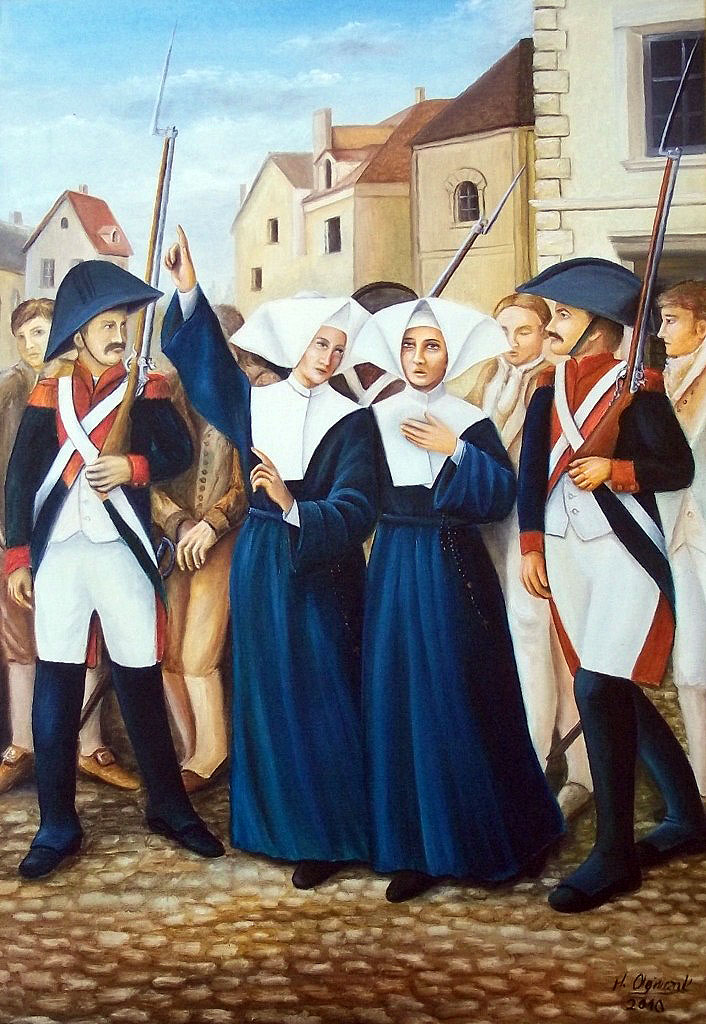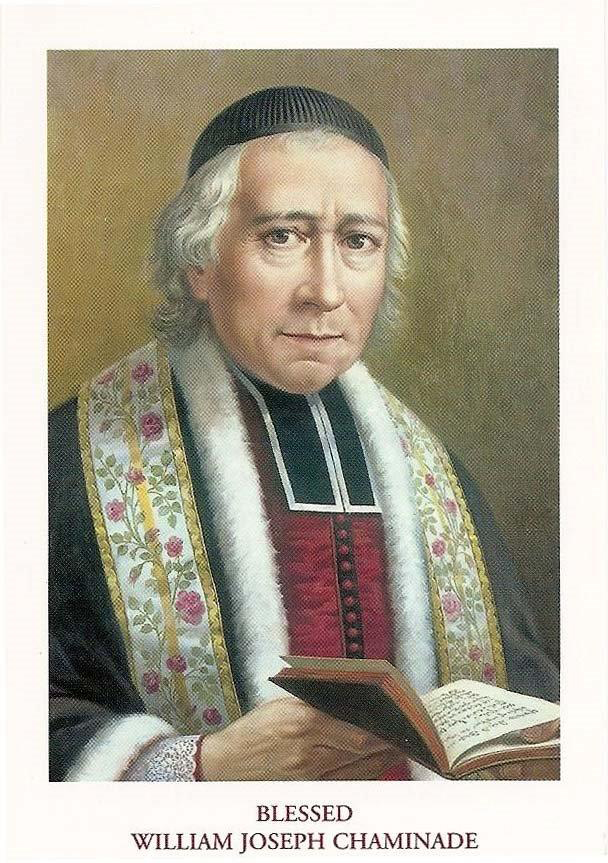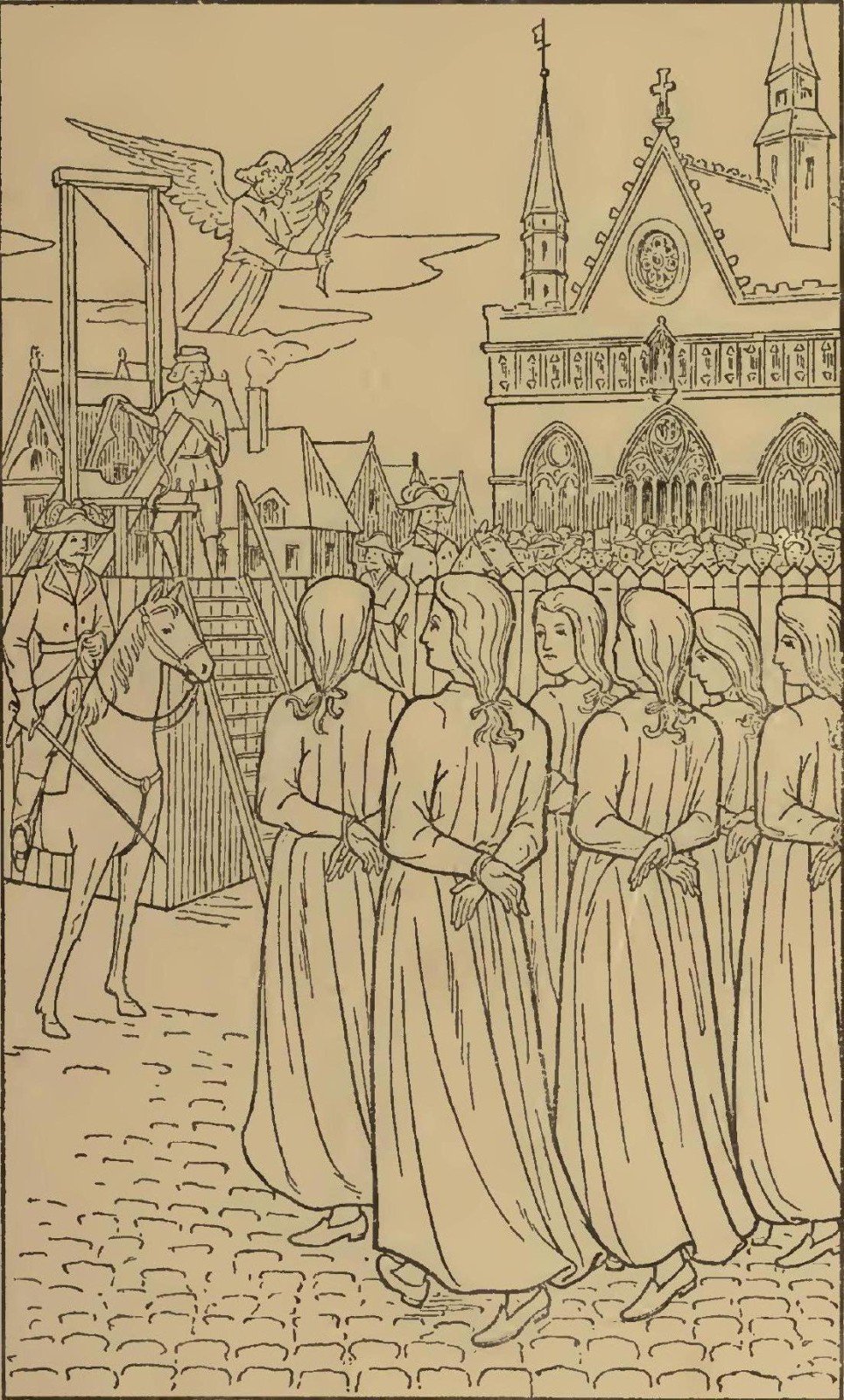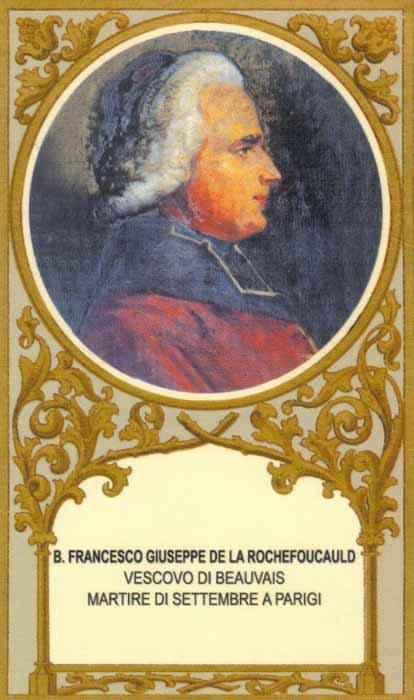
-arrested Daughters of Charity, Srs Odile Baumgarten, DC & Marie-Anne Vaillot, DC
“First, there are the many martyrs who, in the Diocese of Angers , in the time of the French Revolution, accepted death because they wanted to, in the words of William Repin, “keep their faith and religion “firmly attached to the Roman Catholic Church; priests, they refused to take an oath considered schismatic, they would not abandon their pastoral care; laity, they remained faithful to the priests at the Mass celebrated by them, the signs of their worship to Mary and the saints.
Undoubtedly, in a context of great ideological tensions, political and military, one could pose to them infidelity suspicions to the homeland, we have them, in the “whereas” of sentences, accused of compromising with “the forces anti-revolutionary “; it is also well in almost all the persecutions, yesterday and today. But for the men and women whose names were chosen – among many others probably also deserving – they answered the interrogations of the courts, leaves no doubt about their determination to remain faithful – risking their lives – that their faith required, nor the profound reason for their condemnation, hatred of the faith that their judges despised as “unsustainable devotion” and “fanaticism.”
We remain in awe of the decisive answers, calm, brief, frank, humble, that have nothing provocative, but are clear and firm on the essential: the fidelity to the Church. So say the priests, all guillotined as their venerable dean William Repin, the nuns who refuse to even suggest they were sworn in, the four laymen: simply quote the testimony of one of them (Antoine Fournier): “so you should suffer the death in defense of your religion? ” – ” Yes “. Thus speak these eighty women, which cannot be accused of armed rebellion! Some had previously expressed a desire to die for the name of Jesus rather than renounce the religion (Renée Feillatreau). (Fifteen, who could afford it by confiscation of their goods, were guillotined. The eighty-four others were shot and dumped in mass graves.)
True Christians, they also evidenced by their refusal to hate their tormentors, for their pardon their desire for peace for all: “I have asked the Good Lord for the peace and unity of all” (Marie Cassin) . Finally, their last moments show the depth of their faith. Some sing hymns and psalms to the place of execution; “They ask few minutes to make to God the sacrifice of their lives, they did so fervently that their torturers themselves were astonished.” Sister Marie-Anne, Daughter of Charity, comforts and his sister, “We’ll have the joy of seeing God and possessing Him for all eternity … and we will be owned without fear of being separated” (testimony of Abbot Gruget).
Today these ninety-nine martyrs of Angers are associated, in the glory of beatification, the first of them, Father Noel Pinot beatified for almost 60 years.”
-Homily of Pope John Paul II, 19 Feb 1984, Mass of Beatification



Blessed Noel Pinot, priest & martyr (feast February 21), Noel was born at Angers in 1747. He became a priest and excelled in ministering to the sick. In 1788, he was made pastor at a parish in Louroux Beconnais, which he revitalized spiritually through his piety and preaching.
Father Noel refused to take the oath of allegiance to the new French Republic which denied the authority of the Church, and was sentenced to be deprived of his parish for two years. Nonetheless, he continued to carry out his ministry in secret. Later, the holy priest even took clandestine possession of his parish and continued his pastoral work, managing to avoid capture for his defiance of the Revolutionary edict.
However, one day while fully vested for Mass, Father Noel was captured and dragged through the streets to the jeers of hostile spectators and soldiers. He remained in jail for twelve days and was given the death sentence for refusing to take the oath. The holy priest went to the guillotine still vested for Mass and uttering the words that began the pre-Vatican II Mass: “I will go to the altar of God, to God Who gives joy to my youth.” He joined his sacrifice to that of his Master on February 21, 1794, and was beatified in 1926.
Blessed Renee-Marie Feillatreau was born in Angers, France, in 1751. A wife and mother, she was accused of being involved with Catholic “brigands,” of encouraging non-conformist priests, robbing the Republic by hiding sacred vestments and vessels, and of shouting, “Long live religion! Long live the King!” Her guilt actually lay in her devotion to her Catholic faith.
Renee-Marie declared before her judges that she would rather die than renounce her faith, and that she did indeed visit and protect priests of the Roman Catholic Church and had attended their Masses.
Blessed Renee-Marie Feillatreau was guillotined on March 28, 1794, and beatified in 1984.

Names of the beati by canonical state:
Guillaume Répin (1709-1794), Priest
Priests (11).
1. Laurent Bâtard
2. François-Louis Chartier
3. André Fardeau
4. Jacques Laigneau de Langellerie
5. Jean-Michel Langevin
6. Jacques Ledoyen
7. Jean-Baptiste Lego
8. René Lego
9. Joseph Moreau
10. François Peltier
11. Pierre Tessier
Religious (3).
12. Odile Baumgarten
13. Rosalie du Verdier de la Sorinière
14. Marie-Anne Vaillot
Laymen (4).
15. Pierre Delépine
16. Antoine Fournier
17. Pierre Frémond
18. Jean Ménard
Laywomen (80).
19. Gabrielle Androuin
20. Perrine Androuin
21. Suzanne Androuin
22. Victoire Bauduceau Réveillère
23. Françoise Bellanger
24. Louise Bessay de la Voûte
25. Perrine Besson
26. Madeleine Blond
27. Françoise Bonneau
28. Renée Bourgeais Juret
29. Jeanne Bourigault
30. Perrine Bourigault
31. Madeleine Cady
32. Renée Cailleau Girault
33. Marie Cassin
34. Marie-Jeanne Chauvigné Rorteau
35. Simone Chauvigné Charbonneau
36. Catherine Cottenceau
37. Carole Davy
38. Louise-Aimée Dean de Luigné
39. Marie de la Dive du Verdier
40. Anne-Françoise de Villeneuve
41. Catherine du Verdier de la Sorinière
42. Marie-Louise du Verdier de la Sorinière
43. Marie Fasseuse
44. Renée-Marie Feillatreau
45. Marie Forestier
46. Jeanne Fouchard Chalonneau
47. Marie Gallard Queson
48. Marie Gasnier Mercier
49. Marie Gingueneau Couffard
50. Jeanne Gourdon Moreau
51. Marie Grillard
52. Renée Grillard
53. Perrine Grille
54. Jeanne Gruget Doly
55. Victoire Gusteau
56. Marie-Anne Hacher du Bois
57. Anne Hmard
58. Marie Lardeux
59. Perrine Laurent
60. Perrine Ledoyen
61. Jeanne-Marie Leduc Paquier
62. Marie Lenée Lepage Varancé
63. Marie Leroy Brevet
64. Marie Leroy
65. Carola Lucas
66. Renée Martin
67. Anne Maugrain
68. Françoise Michau
69. Françoise Micheneau Gillot
70. Jacqueline Monnier
71. Jeanne Onillon
72. Françoise Pagis Roulleau
73. Madeleine Perrotin Rousseau
74. Perrine Phélyppeaux Sailland
75. Marie Pichery Delahaye
76. Monique Pichery
77. Marie Piou Supiot
78. Louise Poirier Barré
79. Perrine-Renée Potier Turpault
80. Marie-Geneviève Poulain de la Forestrie
81. Marthe Poulain de la Forestrie
82. Félicité Pricet
83. Rose Quenion
84. Louise Rallier de la Tertinière Dean de Luigné
85. Renée Regault Papin
86. Marguerite Rivière Huau
87. Marguerite Robin
88. Marie Rochard
89. Marie Roger Chartier
90. Marie Roualt Bouju
91. Jeanne-Marie Sailland d’Epinatz
92. Madeleine Sailland d’Epinatz
93. Perrine-Jeanne Sailland d’Epinatz
94. Madeleine Sallé
95. Renée Seichet Dacy
96. Françoise Suhard Ménard
97. Jeanne Thomas Delaunay
98. Renée Valin

Names of beati by date of execution:
30 October 1793 in Angers, Maine-et-Loire (France)
1. JEAN-MICHEL LANGEVIN
priest of the diocese of Angers
born: 28 September 1731 in Ingrandes, Maine-et-Loire (France)
01 January 1794 in Angers, Maine-et-Loire (France)
2. RENÉ LEGO
priest of the diocese of Angers
born: 05 October 1764 in La Flèche, Sarthe (France)
3. JEAN LEGO
priest of the diocese of Angers
born: 13 May 1766 in La Flèche, Sarthe (France)
02 January 1794 in Angers, Maine-et-Loire (France)
4. GUILLAUME REPIN
priest of the diocese of Angers
born: 26 August 1709 in Thouarcé, Maine-et-Loire (France)
5. LAURENT BATARD
priest of the diocese of Angers
born: 04 February 1744 in Saint-Maurille de Chalonnes-sur-Loire, Maine-et-Loire (France)
05 January 1794 in Angers, Maine-et-Loire (France)
6. JACQUES LEDOYEN
priest of the diocese of Angers
born: 03 April 1760 in Rochefort-sur-Loire, Maine-et-Loire (France)
7. FRANÇOIS PELTIER
priest of the diocese of Angers
born: 26 April 1728 in Savennières, Maine-et-Loire (France)
8. PIERRE TESSIER
priest of the diocese of Angers
born: 11 May 1766 in La Trinité-d’Angers, Maine-et-Loire (France)
12 January 1794 in Avrillé, Maine-et-Loire (France)
9. ANTOINE FOURNIER
layperson of the diocese of Angers; married
born: 26 January 1736 in La Poitevinière, Maine-et-Loire (France)
18 January 1794 in Avrillé, Maine-et-Loire (France)
10. VICTOIRE GUSTEAU
layperson of the diocese of Angers
born: ca. 1745 in Châtillon-sur-Sèvre, Deux-Sèvres (France)
11. CHARLOTTE LUCAS
layperson of the diocese of Angers
born: 01 April 1752 in Chalonnes-sur-Loire, Maine-et-Loire (France)
12. MONIQUE PICHERY
layperson of the diocese of Angers
born: 04 April 1762 in Chalonnes-sur-Loire, Maine-et-Loire (France)
13. FÉLICITÉ PRICET
layperson of the diocese of Angers
born: ca. 1745 in Châtillon-sur-Sèvre, Maine-et-Loire (France)
26 January 1794 in Angers, Maine-et-Loire (France)
14. MARIE DE LA DIVE veuve DU VERDIER DE LA SORINIÈRE
layperson of the diocese of Angers; married
born: 18 May 1723 in Saint-Crespin-sur-Moine, Maine-et-Loire (France)
27 January 1794 in Angers, Maine-et-Loire (France)
15. ROSALIE DU VERDIER DE LA SORINIÈRE [SŒUR SAINT CELESTE]
professed religious, Benedictine Nuns of Our Lady of Calvary (n.o.)
born: 12 August 1745 in Saint-Pierre de Chemillé, Maine-et-Loire (France)
01 February 1794 in Avrillé, Maine-et-Loire (France)
16. MARIE-ANNE VAILLOT
vowed member, Daughters of Charity of Saint Vincent de Paul
born: 13 May 1736 in Fontainebleau, Maine-et-Loire (France)
17. ODILE BAUMGARTEN
vowed member, Daughters of Charity of Saint Vincent de Paul
born: 15 November 1750 in Gondrexange, Moselle (France)
18. GABRIELLE ANDROUIN
layperson of the diocese of Angers
born: 06 September 1755 in Saint-Lambert-du-Lattay, Maine-et-Loire (France)
19. PERRINE ANDROUIN
layperson of the diocese of Angers
born: 31 August 1760 in Saint-Lambert-du-Lattay, Maine-et-Loire (France)
20. SUZANNE ANDROUIN
layperson of the diocese of Angers
born: 16 March 1757 in Saint-Lambert-du-Lattay, Maine-et-Loire (France)
21. VICTOIRE BAUDUCEAU épouse RÉVÉLIÈRE
layperson of the diocese of Angers; married
born: 20 September 1745 in Thouars, Deux-Sèvres (France)
22. FRANÇOISE BELLANGER
layperson of the diocese of Angers
born: 24 June 1735 in La Trinité-d’Angers, Maine-et-Loire (France)
23. PERRINE BESSON
layperson of the diocese of Angers
born: ca. 1742 in Essarts, Vendée (France)
24. MADELEINE BLOND
layperson of the diocese of Angers
born: ca. 1763 in Angers, Maine-et-Loire (France)
25. FRANÇOISE BONNEAU
layperson of the diocese of Angers
born: ca. 1763 in Saint-Léger-en-Anjou (a.k.a. Saint-Léger-sous-Cholet), Maine-et-Loire (France)
26. JEANNE BOURIGAULT
layperson of the diocese of Angers
born: 24 October 1757 in Chaudefonds, Maine-et-Loire (France)
27. RENÉE CAILLEAU épouse GIRAULT
layperson of the diocese of Angers; married
born: 06 July 1752 in Saint-Aubin-de-Luigné, Maine-et-Loire (France)
28. MARIE CASSIN épouse MOREAU
layperson of the diocese of Angers; married
born: 21 January 1750 in Chanteloup, Maine-et-Loire (France)
29. SIMONE CHAUVIGNÉ veuve CHARBONNEAU
layperson of the diocese of Angers; married
born: 12 March 1728 in Chaudefonds, Maine-et-Loire (France)
30. MARIE-JEANNE CHAUVIGNÉ épouse RORTEAU
layperson of the diocese of Angers; married
born: 21 February 1755 in La Jumellière, Maine-et-Loire (France)
31. CATHERINE COTTANCEAU
layperson of the diocese of Angers
born: ca. 1733 in Bressuire, Deux-Sèvres (France)
32. CHARLOTTE DAVY
layperson of the diocese of Angers
born: 19 October 1760 in Chalonnes-sur-Loire, Maine-et-Loire (France)
33. LOUISE DÉAN DE LUIGNÉ
layperson of the diocese of Angers
born: 17 November 1757 in Argeton-Notre-Dame, Mayenne (France)
34. ANNE-FRANÇOISE DE VILLENEUVE
layperson of the diocese of Angers
born: 11 September 1741 in Seiches-sur-le-Loir, Maine-et-Loire (France)
35. MARIE FAUSSEUSE épouse BANCHEREAU
layperson of the diocese of Angers; married
born: ca. 1740 in Boësse, Deux-Sèvres (France)
36. JEANNE FOUCHARD épouse CHALONNEAU
layperson of the diocese of Angers; married
born: 10 September 1747 in Chalonnes-sur-Loire, Maine-et-Loire (France)
37. MARIE GALLARD épouse QUESSON
layperson of the diocese of Angers; married
born: ca. 1739 in Saint-Laurent-de-la-Plaine, Maine-et-Loire (France)
38. MARIE GASNIER épouse MERCIER
layperson of the diocese of Angers; married
born: 08 November 1756 in Ménil, Mayenne (France)
39. MARIE GRILLARD
layperson of the diocese of Angers
born: 05 October 1753 in Saint-Pierre de Cholet, Maine-et-Loire (France)
40. RENÉE GRILLARD
layperson of the diocese of Angers
born: 10 February 1766 in Saint-Pierre de Cholet, Maine-et-Loire (France)
41. PERRINE GRILLE
layperson of the diocese of Angers
born: 06 February 1742 in Rochefort-sur-Loire, Maine-et-Loire (France)
42. JEANNE GRUGET veuve DOLY
layperson of the diocese of Angers; married
born: ca. 1745 in Châtillon-sur-Sevre, Deux-Sèvres (France)
43. ANNE HAMARD
layperson of the diocese of Angers
born: ca. 1742 in Saint-Clément, Maine-et-Loire (France)
44. PERRINE LEDOYEN
layperson of the diocese of Angers
born: 16 September 1764 in Saint-Aubin-de Luigné, Maine-et-Loire (France)
45. MARIE LENÉE épouse LEPAGE DE VARANCÉ
layperson of the diocese of Angers; married
born: 14 July 1729 in Saint-Nicolas de Saumur, Maine-et-Loire (France)
46. MARIE LEROY épouse BREVET
layperson of the diocese of Angers; married
born: ca. 1755 in (?)
47. MARIE LEROY
layperson of the diocese of Angers
born: 19 May 1771 in Montilliers, Maine-et-Loire (France)
48. RENÉE MARTIN épouse MARTIN
layperson of the diocese of Angers; married
born: ca. 1752 in (?)
49. FRANÇOISE MICHAU
layperson of the diocese of Angers
born: ca. 1765 in (?)
50. JACQUINE MONNIER
layperson of the diocese of Angers
born: 16 January 1726 in Saint-Melaine, Maine-et-Loire (France)
51. FRANÇOISE PAGIS épouse RAILLEAU
layperson of the diocese of Angers; married
born: 14 October 1732 in Gouis, Maine-et-Loire (France)
52. MADELEINE PERROTIN veuve ROUSSEAU
layperson of the diocese of Angers; married
born: 30 March 1744 in Saint-Germain-des-Près, Maine-et-Loire (France)
53. PERRINE-CHARLOTTE PHELIPPEAUX épouse SAILLAND D’EPINATZ
layperson of the diocese of Angers; married
born: 13 May 1740 in Saint-Nicolas de Saumur, Maine-et-Loire (France)
54. MARIE ANNE PICHERY épouse DELAHAYE
layperson of the diocese of Angers; married
born: 30 July 1754 in Chalonnes-sur-Loire, Maine-et-Loire (France)
55. ROSE QUENION
layperson of the diocese of Angers
born: 20 January 1764 in Mozé-sur-Louet, Maine-et-Loire (France)
56. LOUISE-OLYMPE RALLIER DE LA TERTINIÈRE veuve DÉAN DE LUIGNÉ
layperson of the diocese of Angers; married
born: 24 April 1732 in Châteaugontier, Mayenne (France)
57. MARGUERITE RIVIÈRE épouse HUAU
layperson of the diocese of Angers; married
born: 20 August 1756 in La Ferrière-de-Flée, Maine-et-Loire (France)
58. MARIE ROUAULT épouse BOUJU
layperson of the diocese of Angers; married
born: 26 October 1744 in Vezins, Maine-et-Loire (France)
59. PERRINE SAILLAND D’EPINATZ
layperson of the diocese of Angers
born: 24 March 1768 in Saint-Nicolas de Saumur, Maine-et-Loire (France)
60. JEANNE SAILLAND D’EPINATZ
layperson of the diocese of Angers
born: 03 July 1769 in Saint-Nicolas de Saumur, Maine-et-Loire (France)
61. MADELEINE SAILLAND D’EPINATZ
layperson of the diocese of Angers
born: 09 August 1770 in Saint-Nicolas de Saumur, Maine-et-Loire (France)
62. RENÉE VALIN
layperson of the diocese of Angers
born: 08 March 1760 in Chaudefonds, Maine-et-Loire (France)
10 February 1794 in Avrillé, Maine-et-Loire (France)
63. LOUISE BESSAY DE LA VOUTE
layperson of the diocese of Angers
born: 22 August 1721 in Saint-Mars-des-Prés, Vendée (France)
64. CATHERINE DU VERDIER DE LA SORINIÈRE
layperson of the diocese of Angers
born: 29 June 1758 in Saint-Pierre de Chemillé, Maine-et-Loire (France)
65. MARIE-LOUISE DU VERDIER DE LA SORINIÈRE
layperson of the diocese of Angers
born: 27 June 1765 in Saint-Pierre de Chemillé, Maine-et-Loire (France)
66. PIERRE FRÉMOND
layperson of the diocese of Angers
Marie-Anne Hacher du Bois born: 16 September 1754 in Chaudefonds, Maine-et-Loire (France)
67. MARIE-ANNE HACHER DU BOIS
layperson of the diocese of Angers
born: 03 April 1765 in Jallais, Maine-et-Loire (France)
68. LOUISE POIRIER épouse BARRÉ
layperson of the diocese of Angers; married
born: 22 February 1754 in Le Longeron, Maine-et-Loire (France)
22 March 1794 in Angers, Maine-et-Loire (France)
69. FRANÇOIS CHARTIER
priest of the diocese of Angers
born: 06 June 1752 in Marigné, Maine-et-Loire (France)
28 March 1794 in Angers, Maine-et-Loire (France)
70. RENÉE-MARIE FEILLATREAU épouse DUMONT
layperson of the diocese of Angers; married
born: 08 February 1751 in Angers, Maine-et-Loire (France)
16 April 1794 in Avrillé, Maine-et-Loire (France)
71. PIERRE DELÉPINE
layperson of the diocese of Angers
born: 24 May 1732 in Marigné, Maine-et-Loire (France)
72. JEAN MÉNARD
layperson of the diocese of Angers; married
born: 16 November 1736 in Andigné, Maine-et-Loire (France)
73. RENÉE BOURGEAIS veuve JURET
layperson of the diocese of Angers; married
born: 12 November 1751 in Montjean, Maine-et-Loire (France)
74. PERRINE BOURIGAULT
layperson of the diocese of Angers
born: 07 August 1743 in Montjean, Maine-et-Loire (France)
75. MADELEINE CADY épouse DESVIGNES
layperson of the diocese of Angers; married
born: 07 April 1756 in Saint-Maurille de Chalonnes-sur-Loire, Maine-et-Loire (France)
76. MARIE FORESTIER
layperson of the diocese of Angers
born: 16 January 1768 in Montjean, Maine-et-Loire (France)
77. MARIE GINGUENEAU veuve COIFFARD
layperson of the diocese of Angers; married
born: ca. 1739 in (?)
78. JEANNE GOURDON veuve MOREAU
layperson of the diocese of Angers; married
born: 08 October 1733 in Sainte-Christine, Maine-et-Loire (France)
79. MARIE LARDEUX
layperson of the diocese of Angers
born: ca. 1748 in (?)
80. PERRINE LAURENT
layperson of the diocese of Angers
born: 02 September 1746 in Louvaines, Maine-et-Loire (France)
81. JEANNE LEDUC épouse PAQUIER
layperson of the diocese of Angers; married
born: 10 February 1754 in Chalonnes-sur-Loire, Maine-et-Loire (France)
82. ANNE MAUGRAIN
layperson of the diocese of Angers
born: 12 April 1760 in Rochefort-sur-Loire, Maine-et-Loire (France)
83. FRANÇOISE MICHENEAU veuve GILLOT
layperson of the diocese of Angers; married
born: 19 May 1737 in Chanteloup-les-Bois, Maine-et-Loire (France)
84. JEANNE ONILLON veuve ONILLON
layperson of the diocese of Angers; married
born: 19 April 1753 in Montjean, Maine-et-Loire (France)
85. MARIE PIOU épouse SUPIOT
layperson of the diocese of Angers; married
born: 19 May 1755 in Montrevault, Maine-et-Loire (France)
86. PERRINE POTTIER épouse TURPAULT
layperson of the diocese of Angers; married
born: 26 April 1750 in Cléré-sur-Layon, Maine-et-Loire (France)
87. MARIE-GENEVIEVE POULAIN DE LA FORESTRIE
layperson of the diocese of Angers
born: 03 January 1741 in Lion-d’Angers, Maine-et-Loire (France)
88. MARTHE POULAIN DE LA FORESTRIE
layperson of the diocese of Angers
born: 02 October 1743 in Lion-d’Angers, Maine-et-Loire (France)
89. RENÉE RIGAULT épouse PAPIN
layperson of the diocese of Angers; married
born: 14 May 1750 in Saint-Florent-le-Vieil, Maine-et-Loire (France)
90. MARGUERITE ROBIN
layperson of the diocese of Angers
born: 22 December 1725 in Montjean, Maine-et-Loire (France)
91. MARIE RECHARD
layperson of the diocese of Angers
born: 29 April 1763 in Montjean, Maine-et-Loire (France)
92. MARIE ROGER veuve CHARTIER
layperson of the diocese of Angers; married
born: 14 January 1727 in Montjean, Maine-et-Loire (France)
93. MADELEINE SALLÉ épouse HAVARD
layperson of the diocese of Angers; married
born: ca. 1751 in (?)
94. RENÉE SECHET veuve DAVY
layperson of the diocese of Angers; married
born: 28 December 1753 in Montjean, Maine-et-Loire (France)
95. FRANÇOISE SUHARD veuve MÉNARD
layperson of the diocese of Angers; married
born: February 5, 1731 in Saint-Gemmes-d’Andigné, Maine-et-Loire (France)
96. JEANNE THOMAS veuve DELAUNAY
layperson of the diocese of Angers; married
born: ca. 1730 in (?)
18 April 1794 in Angers, Maine-et-Loire (France)
97. JOSEPH MOREAU
priest of the diocese of Angers
born: 21 October 1763 in Saint-Laurent-de-la-Plaine, Maine-et-Loire (France)
24 August 1794 in Angers, Maine-et-Loire (France)
98. ANDRÉ FARDEAU
priest of the diocese of Angers
born: 19 November 1761 in Soucelles, Maine-et-Loire (France)
14 October 1794 in Angers, Maine-et-Loire (France)
99. JACQUES LAIGNEAU DE LANGELLERIE
priest of the diocese of Angers
born: 17 April 1747 in La Flèche, Sarthe (France)
The hospital of Saint-Jean was one of the oldest hospitals in France, founded in 1175 by Henri Plantagenet, Count of Anjou and King of England, to expiate for the murder of Thomas Becket. By the seventeenth century it needed restructuring, as the mayor, aldermen, and townspeople attested. The Bishop of Angers, Claude de Rueil, and the Abbe de Vaux, addressed themselves to Saint Vincent de Paul with the request for the Daughters of Charity. In December 1639 Saint Louise de Marillac herself brought there the first Daughters of Charity, the first to leave the environs of Paris and the Motherhouse. The contract between the Company of the Daughters of Charity and the administrators of the hospital was signed February 1, 1640.
In the rules which he wrote in collaboration with Saint Louise, Saint Vincent specified the reasons for the mission to Angers:
“The Daughters of Charity of the poor sick have gone to Angers to honor Our Lord, the Father of the Poor and His Blessed Mother, to assist, both bodily and spiritually, the sick poor of the Hotel Dieu in that city. Corporally by ministering to them and providing them with food and medicine, and spiritually by instructing the sick in the things necessary to salvation and, when they need a confession of their whole past life, by arranging the means for it, for those who would die in this state and for those who would be cured by resolving never more to offend God.”
Saint Vincent then proposed for them the means to be faithful to God and to become Good Servants of the Poor:
“The first thing Our Lord asks of them is that they love Him above all and that all their actions be done for love of Him. Secondly, that they cherish each other as Sisters whom He has united by the bond of His love, and the sick poor as their masters since Our Lord is in them and they in Our Lord.”
In 1790 the revolutionary Assembly in France ordered the confiscation of all religious property and on July 12, 1790 promulgated the Civil Constitution of the Clergy which made the clergy functionaries of the state and the Church a national church.
In November the government demanded that the clergy take a prescribed oath: “I swear to be faithful to the nation, to the law, to the king, and to uphold with all my power the Constitution decreed by the National Assembly and accepted by the king.”
The Reign of Terror in Angers
On September 2, 1793, local revolutionaries were annoyed to hear that the Sisters were still working peacefully at the hospital of Saint-Jean. A petition was sent to the municipality: at all cost, and as soon as possible, the Sisters must be made to take the oath and shed their habit. The Sisters replied that the oath was meant only for public office holders; that their sole function was to look after the sick; that up to this time they had not disturbed public order; that, for these reasons, they considered themselves dispensed from all oaths, and that they would not take any. Yet, some weeks later the sisters were made to change their habits. From Sister Marie-Anne’s own words, on the day of her interrogation: the sacrifice of the holy habit was one of the most painful of her life. On their new headdress the Sisters had to wear the national cockade, which had been made obligatory for women by law.

The year 1793 drew to a close amidst continual alarms. On the night of November 11, the cathedral of Angers was pillaged, the statues mutilated or broken, the tombs desecrated. The clock of the church of the Trinity, close by the hospital, was pulled down, the crucifix destroyed. Christmas passed without Mass. The very name of Christmas had been eliminated from the Republican calendar.”

-by Casey Chalk
“Today (Jan 2) we celebrate the feast day of Blessed Guillaume Repin, a priest and martyr who was executed in 1793 by order of a committee of the French revolutionary government. Repin was linked to the counter-revolutionary “Catholic and Royal Army” in the western French department of the Vendée, which in 1793 launched a brief, heroic insurgency against a Jacobin regime attempting to destroy the Catholic Church in France. Though little known today, the Vendée uprising represents an inspiring (and instructive) story, relevant for 2023, of Catholic triumph against secular regimes.
One of the acts of the anti-Catholic French revolutionary government was the Civil Constitution of the Clergy, which required all clerics to pledge allegiance to the Constitution, subordinating the clergy to the French government. It was deeply unpopular in the devoutly Catholic Vendée region. When the revolutionary Republican government enacted a nationwide conscription in March 1793, the residents of the Vendée took up arms, demanding the reopening of their parish churches, many of which had been seized by the government.

Between March and December 1793, thousands of Catholic royalist forces engaged in a number of pitched battles—as well as constant guerrilla warfare—against the forces of the Republic. For a time, the Catholics, who wore a patch dedicated to the Sacred Heart of Jesus, won a number of victories. Yet numbers and munitions were not on their side. Defeats in the fall of 1793 culminated in the December 23, 1793 Battle of Savenay, at which a Republican force of approximately 18,000 decisively defeated the Catholic and Royal Army of about 6,000.
After the battle, Republican General François Joseph Westermann is reported to have written to his superiors: “The Vendée is no more. . . . According to your orders, I have trampled their children beneath our horses’ feet; I have massacred their women, so they will no longer give birth to brigands. I do not have a single prisoner to reproach me. I have exterminated them all.”
The authenticity of Westermann’s letter is disputed, but it’s not hard to find examples elsewhere of atrocities committed by the French Republicans. Between November 1793 and February 1794 in the city of Nantes, suspected royalist sympathizers, as well as Catholic priests and nuns, were systematically drowned in the river Loire. About 4,000 people, including many women and children, were killed. More than 2,000 more victims were killed by firing squad at a quarry near Nantes. It is estimated that between January and May 1794, as many as 50,000 civilians of the Vendée were massacred.
One of those civilians was Father Guillaume Repin. The French priest had been arrested by Republican authorities in 1792 but freed by Royalists a year later. Because of his old age, he was unable to flee far, and was captured again a year later. He was sentenced to the guillotine and executed on January 2, 1794. He was eighty-three years old.
Why would a powerful political regime feel so threatened by an elderly priest, unable even to evade his own captors, that they felt compelled to execute him? The answer is found in how totalizing the French revolutionaries’ ambitions were to destroy Catholicism in France, the “eldest daughter of the Church.” The Jacobins sought to destroy all objects of Catholic veneration, including icons, statues, and crosses. It confiscated Church property. It subverted the Church’s centrality to the family by taking control over birth, death, and marriage registers. It created a new, secular calendar and civic cults based on “reason.” It wanted, in sum, a Catholicism so weakened and neutralized it could be easily dominated by the state.
This “Reign of Terror” did eventually subside. Many of the Jacobins were killed, Napoleon assumed power, and the country even today remains nominally Catholic. But the damage was done. Thousands of French churches never reopened. In little over a decade, 20,000 priests abdicated their ordinations under threat of death; another 30,000 were forced to leave a country of about 28 million people. (The United States, a country that has more than 60 million Catholics, has less than 40,000 priests today.) Only fifteen percent of Frenchmen today are practicing Catholics, and under five percent attend Mass weekly.
It could be said that we Americans today suffer the results of that secularizing effort that began 230 years ago. Today, many prominent politicians, while proudly claiming their Catholic identity, place their allegiance to their party and its policies over Church doctrine. About thirty million people, or ten percent of the population, are ex-Catholics. In the last fifty years, the number of Catholic priests in America has decreased by 60 percent. In recent decades, hundreds of churches have closed, a trend accelerated by the COVID-19 pandemic.
The enemies of the Church have realized that you don’t need to imprison or kill clergy and devout laymen to render Catholicism harmless (though the late Chicago cardinal Francis George warned that his successors might in time suffer such fates). Just as effective is to weaken its public influence—say, by closing Catholic adoption agencies or attacking Catholic hospitals. Alternatively, the institutions of secular power foreground so-called Catholic voices who question or reject Catholic teaching, muddying the Church’s witness and persuading many Catholics that autonomy and freedom, those pre-eminent goods of liberalism, are what matters most.
The result is more or less the same as what happened in France. The Church’s influence over culture is a shadow of what it was two generations ago. Practicing Catholics realize that many of their public schools and libraries, which promote radical sexual ideology, are not safe places for their children. “Pride Month” increasingly rivals Christmas as the most important event in our civic calendar—and even Christmas is not safe from drag queens. It feels as though we are strangers in a strange land, as it did for pious Catholics in the Vendée many years ago.
And yet there is hope. Almost fifty years to the day after Blessed Guillaume Repin was martyred, a little girl was born to a miller and his laundress wife in southwestern France. They named her Bernadette. Fourteen years later, the girl would see a vision of the Virgin Mary that would result in the conversions and healing of thousands and the confirmation of a dogma: the Immaculate Conception, promulgated in 1854. Five million pilgrims visit Lourdes, the site of that Marian apparition, every year.
The many miracles at Lourdes, and the horrors of the war in the Vendée that preceded them, are a necessary reminder as we begin a new year: as much as Christ’s enemies may try to undermine and destroy his Church, he will continue to build his kingdom, often from its own ruins. The continued spiritual power of an elderly cleric and a little peasant girl in France prove the point.”
Notre Père qui êtes aux cieux, que votre nom soit sanctifié, que votre règne arrive, que votre volonté soit faite sur la terre comme au ciel. Donnez nous aujourd’hui notre pain quotidien; pardonnez nous nos offenses comme nous pardonnons à ceux qui nous ont offensés; et ne nous laissez pas succomber à la tentation; mais délivrez nous du mal. Ainsi soit-il.
Je vous salue Marie, Marie pleine de grâce, le Seigneur est avec vous, Vous êtes bénieentre toute les femmes, et Jésus, le fruit de vos entrailles, est béni. Sainte Marie, Mère de Dieu, priez pour nous, pauvres pécheurs, maintenant et à l’heure de notre mort. Ainsi soit-il
Je crois en Dieu, le Père tout puissant, Créateur du ciel et de la terre, et en Jésus-Christ son fils unique, Notre-Seigneur, qui a été conçu du Saint Esprit, est né de la Vierge Marie, a souffert sous Ponce Pilate, a été crucifié, est mort, a été enseveli; est descendu aux enfers; le troisième jour, est ressucité des morts, est monté aux cieux, est assis à la droite de Dieu le Père tout-puissant, d’où il viendra juger les vivants et les morts.
Je crois au Saint Esprit, à la Sainte Eglise Catholique, à la communion des Saints, à la rémission des péchés, à la résurection de la chair, à la vie éternelle. Ainsi soit-il
Merci, Le Sacré Coeur de Jésus!
Dieu Le Roy!
Love,
Matthew
























